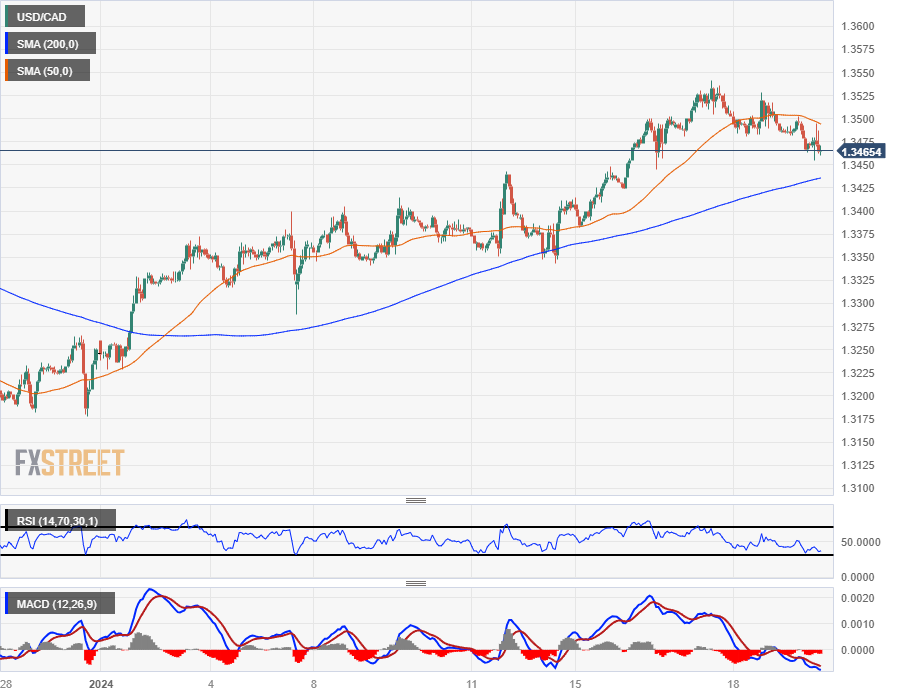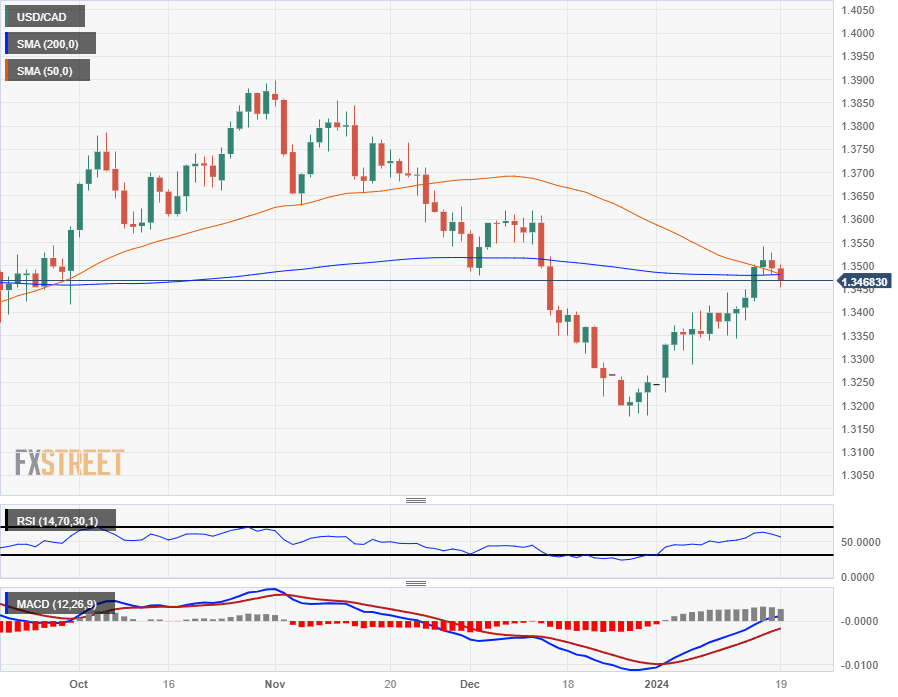- The Canadian dollar rose modestly on Friday amid the oil rally.
- Canada's retail sales fall more than expected, making upside difficult.
- The Canadian dollar advances in the week, but continues to lose ground against the US dollar.
The Canadian Dollar (CAD) rose on Friday, boosted by a surge in crude oil supplies late in the week, while CAD traders ignored the headwinds for now.
Canada reported a faster-than-expected fall in retail sales in November, and the Bank of Canada (BOC) joined the growing list of global central banks expected to deliver rate cuts at a slower, shallower pace. what investors initially expected.
Daily Market Summary: Canadian Dollar Breaks Off Headlines, Rebounds on Friday
- Canadian retail sales fell 0.2% in November, below forecasts that kept them at 0.0% and with a new decline compared to the 0.7% in October.
- Core retail sales accelerated the decline and stood at -0.5% versus -0.1% forecast and 0.4% previously (revised downward from 0.6%).
- The change in employment insurance beneficiaries in Canada rose to 1.7% in November, up from 0.7% previously.
- American consumers' inflation expectations fell in January from 2.9% to 2.8%, according to the University of Michigan (UM) consumer survey.
- The UoM Consumer Sentiment Index also improved in January, rising from 69.7 to 78.8, compared to the forecast of 70.0.
- US existing home sales fell 1% in December, reversing November's 0.8% gain.
- The Bank of Canada is expected to start cutting interest rates much later than expected, according to economists surveyed, with most seeing no change in rates until June at the earliest.
- Overall, rate cuts will be much shallower than investors expected.
- Demand for crude oil from US refineries, as well as the cold snap reducing production rates, are causing US reserves to decline, increasing crude oil supplies ahead of the end of week.
Price of the Canadian Dollar today
Below is the percentage change of the Canadian Dollar (CAD) against the currencies listed today. The Canadian dollar appreciated against the New Zealand dollar.
| USD | EUR | GBP | CAD | AUD | JPY | NZD | CHF | |
| USD | -0.07% | 0.27% | -0.14% | -0.01% | 0.02% | 0.29% | 0.10% | |
| EUR | 0.06% | 0.32% | -0.08% | 0.04% | 0.08% | 0.35% | 0.16% | |
| GBP | -0.27% | -0.36% | -0.44% | -0.30% | -0.26% | 0.02% | -0.17% | |
| CAD | 0.14% | 0.08% | 0.43% | 0.13% | 0.17% | 0.45% | 0.26% | |
| AUD | 0.00% | -0.05% | 0.29% | -0.14% | 0.01% | 0.28% | 0.09% | |
| JPY | -0.01% | -0.11% | 0.26% | -0.18% | -0.04% | 0.27% | 0.09% | |
| NZD | -0.28% | -0.38% | -0.01% | -0.46% | -0.32% | -0.28% | -0.19% | |
| CHF | -0.11% | -0.16% | 0.17% | -0.26% | -0.14% | -0.06% | 0.19% |
The heat map shows the percentage changes of the major currencies against each other. The base currency is chosen in the left column, while the quote currency is chosen in the top row. For example, if you choose the euro in the left column and scroll down the horizontal line to the Japanese yen, the percentage change in the box will represent EUR (base)/JPY (quote).
Technical Analysis: The Canadian Dollar across the board on Friday, USD/CAD loses the 1.3500 level
The Canadian Dollar (CAD) is up against all major currencies on Friday, gaining around four tenths against the British Pound (GBP) and the New Zealand Kiwi (NZD), with the smallest gains of around one tenth against the Euro (EUR) and the Australian dollar (AUD).
The US Dollar was down about a fifth against the Canadian Dollar on Friday, following an intraday rejection of the 1.3500 level before testing the 1.3450 area. In the short term, USD/CAD is retreating towards the 200-day SMA near 1.3430.
The daily candles are fixing on the 200-day SMA just below the 1.3500 level, and USD/CAD could see a technical rejection extending into a bearish pullback with a price floor marked near 1.3200.
Even if buyers find the momentum needed to push USD/CAD above the consolidation of the 50-day and 200-day SMAs near 1.3500, there is still a lot of ground to cover before bids can reclaim the last high set early November around 1.3900.
USD/CAD Hourly Chart

USD/CAD Daily Chart

Frequently Asked Questions about the Canadian Dollar
What factors determine the price of the Canadian dollar?
The key factors that determine the price of the Canadian dollar (CAD) are the level of interest rates set by the Bank of Canada (BoC), the price of oil, Canada's main export product, the health of its economy, inflation and the trade balance, which is the difference between the value of Canadian exports and its imports. Other factors are market confidence, that is, whether investors bet on riskier assets (risk-on) or look for safe assets (risk-off), with the risk-on being positive for the CAD. As its largest trading partner, the health of the US economy is also a key factor influencing the Canadian dollar.
How do Bank of Canada decisions affect the Canadian dollar?
The Bank of Canada (BoC) exerts significant influence over the Canadian Dollar by setting the level of interest rates that banks can lend to each other. This influences the level of interest rates for everyone. The BoC's main objective is to keep inflation between 1% and 3% by adjusting interest rates up or down. Relatively high interest rates are usually positive for the CAD. The Bank of Canada can also use quantitative easing and tightening to influence credit conditions, with the former being negative for the CAD and the latter being positive for the CAD.
How does the price of oil affect the Canadian dollar?
The price of oil is a key factor influencing the value of the Canadian Dollar. Oil is Canada's largest export, so the price of oil tends to have an immediate impact on the value of the CAD. Generally, if the price of oil rises, the CAD also rises, as aggregate demand for the currency increases. The opposite occurs if the price of oil falls. Higher oil prices also tend to lead to a higher probability of a positive trade balance, which also supports the CAD.
How does inflation data influence the value of the Canadian Dollar?
Although inflation has traditionally always been considered a negative factor for a currency, as it reduces the value of money, the opposite has actually happened in modern times, with the relaxation of cross-border capital controls. Higher inflation often leads central banks to raise interest rates, attracting more capital inflows from global investors looking for a lucrative place to store their money. This increases the demand for the local currency, which in the case of Canada is the Canadian Dollar.
How does economic data influence the value of the Canadian dollar?
The published macroeconomic data measures the health of the economy and may have an impact on the Canadian dollar. Indicators such as GDP, manufacturing and services PMIs, employment and consumer confidence surveys can influence the direction of the CAD. A strong economy is good for the Canadian dollar. Not only does it attract more foreign investment, but it may encourage the Bank of Canada to raise interest rates, resulting in a stronger currency. However, if economic data is weak, the CAD is likely to fall.
Source: Fx Street
I am Joshua Winder, a senior-level journalist and editor at World Stock Market. I specialize in covering news related to the stock market and economic trends. With more than 8 years of experience in this field, I have become an expert in financial reporting.







